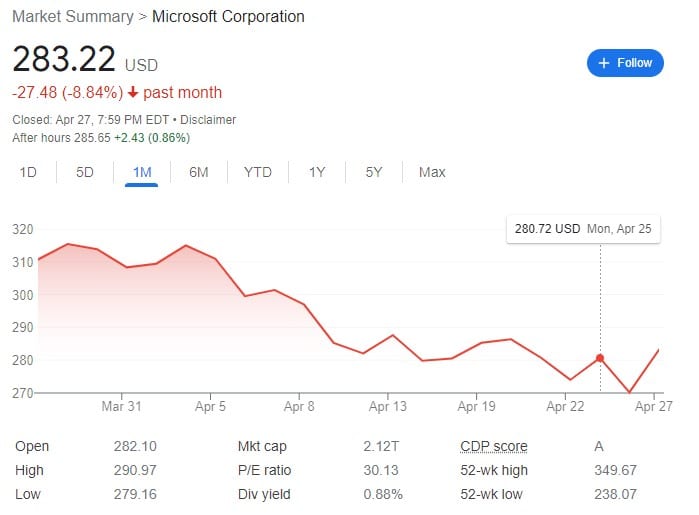
Cloud Services Drive Strong Growth for Microsoft
Cloud services continue to be a strong driver for revenue growth for Microsoft Corp. In the company’s third-quarter financials for fiscal year 2022, the company reported total revenue of $49.4 billion, an 18% increase year-over-year. Microsoft Cloud revenue was $23.4 billion for the quarter with a gross margin of 70% which was down slightly year-over-year.

“It was a record third quarter, driven by the continued strength of the Microsoft Cloud, which surpassed $23 billion in revenue, up 32% year-over-year,” said Microsoft CEO Satya Nadella on the April 26, 2022 earnings call. “Going forward, digital technology will be the key input that powers the world’s economic output. Across the tech stack, we are expanding our opportunity and taking share as we help customers differentiate, build resilience, and do more with less.”
LinkedIn revenue was also strong during the quarter, increasing 34% year-over-year, with record engagement from 830 million professionals using the platform.
“Amid the Great Reshuffle, we’re seeing a skills-first labor market emerge. The number of companies using skills filters on LinkedIn to fill open roles has doubled year-over-year,” Nadella said. “In this dynamic labor market, hires on LinkedIn increased 88%. Talent Solutions revenue was up 43%, marking the sixth consecutive quarter of accelerating growth.”
Other quarterly highlights
Microsoft reported the following highlights for the third quarter of fiscal year 2022:
- Operating income was $20.4 billion, a 19% increase year-over-year.
- Net income was $16.7 billion, an 8% increase year-over-year (GAAP), or $2.22 diluted earnings per share, a 9% increase year-over-year (GAAP).
- Revenue in Productivity and Business Processes was $15.8 billion, a 17% increase year-over-year.
- Office Commercial products and cloud services revenue grew 12%, driven by Office 365 Commercial revenue growth of 17% year-over-year.
- Office Consumer products and cloud services revenue grew 11% year-over-year.
- The company now has 58.4 million Microsoft 365 Consumer subscribers, compared to 56.4 million at the end of the second quarter of fiscal year 2022.
- Dynamics products and cloud services revenue increased 22%, driven by Dynamics 365 revenue growth of 35% year-over-year.
- Revenue in Intelligent Cloud was $19.1 billion, representing a 26% increase year-over-year.
- Server products and cloud services revenue grew 29%, driven by Azure and other cloud services revenue growth of 46% year-over-year.
- Revenue in More Personal Computing was $14.5 billion, representing 11% growth year-over-year.
- Windows OEM revenue increased 11% year-over-year.
- Windows commercial products and cloud services revenue grew 14% year-over-year.
- Xbox content and services revenue increased 4% year-over-year.
- Search and news advertising revenue, excluding traffic acquisition costs, increased 23% year-over-year.
- Surface revenue increased 13%.
- During the quarter, Microsoft returned $12.4 billion to shareholders through share repurchases and dividend payments, an increase of 25% compared to the prior-year period.
Fourth-quarter outlook
Chief financial officer Amy Hood provided guidance for the fourth quarter of fiscal year 2022, after sharing caveats about the company’s outlook. The company expects negative impacts from the foreign exchange rate, a full quarter of impact from the acquisition of Nuance, a revenue impact of approximately $110 million due to the war in Ukraine, and shutdowns in China, including extended shutdowns impacting Windows OEM, Surface and Xbox hardware sales.
“With that context in place, let’s turn to our Q4 outlook. In our largest quarter of the year, we expect our differentiated market position, customer demand across our solution portfolio, and consistent execution to drive another strong quarter of revenue growth,” said Hood.
- Microsoft Cloud’s gross margin percentage is estimated to be down a point year-over-year.
- Capital expenditures will increase as the company makes strategic investments to meet increased demand for their cloud services.
- Revenue in Productivity and Business Processes will range between $16.65 billion and $16.9 billion.
- Revenue in Intelligent Cloud will range between $21.1 billion and $21.35 billion, driven by Azure.
- Revenue in More Personal Computing will range between $14.65 billion and $14.95 billion.
- Interestingly, the company predicts a decrease in Gaming revenue in the mid-to-high single digits due to lower engagement in terms of hours and a restricted supply of consoles. Xbox content and services revenue is also expected to drop in the mid-single digits, but still higher than pre-pandemic levels.
“We expect to close FY22, even in a more complex macro environment, with the same consistency we have delivered throughout the year with strong revenue growth, share gains, and improved operating margins as we invest in the areas that are key to sustaining that growth,” Hood said.
“As we look toward FY23, our track record of delivering high value to our customers across many diverse and durable growth markets gives us confidence that we will drive continued healthy double-digit revenue and operating income growth,” added Hood.
Microsoft stock value
Microsoft investors didn’t have a strong reaction to the company’s news. On April 26, Microsoft stock was valued at $270.22 per share, down $10.50 per share from the prior day. As of 7:59 p.m. EDT yesterday, stock had rebounded to $283.22 per share, up slightly.

Insider Take
Despite the global effects of the pandemic, the Russian invasion of Ukraine, supply chain disruptions and foreign exchange rates, Microsoft continues to exceed performance from the prior year period. Driven by cloud services and segment revenue increases, the company remains on solid ground financially and from a growth perspective. It is interesting to note that Gaming revenue is decreasing, especially with Microsoft’s recent investments in Gaming. We are curious to see when this is expected to rebound, because the company’s acquisition of Activision Blizzard will make Microsoft the third largest gaming company in the world once the deal closes.
- Filed in Business Operations, FInance, News, SaaS and Cloud Services





